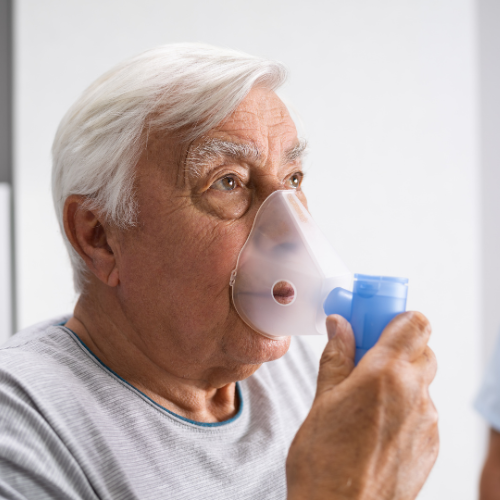Must Know Respiratory Drugs for Nursing School & NextGen NCLEX

Understanding Respiratory Drugs: A Comprehensive Guide
Take a deep breath. The ability to inhale and exhale effortlessly is something we often take for granted. But for those battling respiratory conditions like asthma, chronic obstructive pulmonary disease (COPD), or even the common cold, breathing can become a daily struggle.
Thankfully, the world of respiratory drugs has brought relief and improved the quality of life for millions of individuals!
Before we go any further in this blog post, do not forget to grab your free copy (just pay to ship) of "140 Must Know Meds". The medications in this book were the most tested meds while I was in nursing school. Just click below 👇
In this blog post, we will explore 3 common respiratory diseases, and the medications designed to target these specific respiratory issues.
As a nursing student, it is important to under these medications in order to take the best care of your patients.
Asthma
Asthma is a chronic respiratory condition characterized by inflammation and narrowing of the airways, which leads to recurrent episodes of wheezing, shortness of breath, chest tightness, and coughing. It is a condition that affects the bronchial tubes, the air passages that carry air in and out of the lungs.
When a person with asthma is exposed to certain triggers, such as allergens (e.g., pollen, dust mites, pet dander), respiratory infections, irritants (e.g., smoke, pollution), or physical exertion, the airways become inflamed, causing them to constrict and produce excess mucus.
Nursing Case Study For Pediatric Asthma
Anthony is a 6-year-old male patient brought to the pediatric ER with a history of asthma since he came home from the NICU as an infant. He lives with his parents, Bob and Josh, who adopted him after fostering him from age 4 months. They have tried the usual nebulizer treatments but Anthony is not responding as usual, so they brought him for evaluation.
Initial assessment in triage reveals both inspiratory and expiratory wheezes, dyspnea, tachypnea, diaphoresis, and retractions.
BP 70/40 mmHg SpO2 93% on room air
HR 131 bpm
RR 32bpm at rest Temp 38.3°C
Anthony is pale but not gray. His lips do indicate a very faint bluish tinge. He can speak but it appears difficult.
After the administration of racemic albuterol, Anthony now has a RR of 22 and O2 saturation of 95% on room air. However, the provider decides to admit him to the inpatient pediatric observation unit.
3 Common Drugs Used To Treat Asthma
- Albuterol
- Salmeterol
- Fluticasone
Albuterol
Generic Name for Albuterol
Albuterol
Trade Name for Albuterol
Proventil
Indication for Albuterol
Bronchodilators used to prevent airway obstruction in asthma and COPD
Action for Albuterol
Binds to Beta2 adrenergic receptors in the airway leading to relaxation of the smooth muscles in the airways
Therapeutic Class for Albuterol
Bronchodilator
Pharmacologic Class for Albuterol
Adrenergic
Nursing Considerations for Albuterol
|
|
Salmeterol (Serevent)
Generic Name for Salmeterol (Serevent)
Salmeterol

Trade Name for Salmeterol (Serevent)
Serevent
Indication for Salmeterol (Serevent)
Reversible airway obstruction, exercise-induced asthma
Action for Salmeterol (Serevent)
Bronchodilation through stimulation of beta 2 adrenergic receptors
Therapeutic Class for Salmeterol (Serevent)
Bronchodilators
Pharmacologic Class for Salmeterol (Serevent)
Adrenergics
Nursing Considerations for Salmeterol (Serevent)
|
|
Fluticasone (Flonase)
Generic Name for Fluticasone (Flonase)
Fluticasone
Trade Name for Fluticasone (Flonase)
Flovent, Flonase
Indication for Fluticasone (Flonase)
prophylactic asthma treatment
Action for Fluticasone (Flonase)
locally acting anti-inflammatory
Therapeutic Class for Fluticasone (Flonase)
antiasthmatics, anti-inflammatory (steroid)
Pharmacologic Class for Fluticasone (Flonase)
Corticosteroids, Inhalation
Nursing Considerations for Fluticasone (Flonase)
|
|
COPD (Chronic Obstructive Pulmonary Disease)
COPD stands for Chronic Obstructive Pulmonary Disease. It is a chronic respiratory condition that affects the lungs and makes it difficult to breathe. COPD is typically characterized by two main conditions: chronic bronchitis and emphysema.
Chronic bronchitis involves the inflammation and narrowing of the bronchial tubes, which are the airways that carry air to and from the lungs. This inflammation leads to increased production of mucus, causing a persistent cough and excessive phlegm.
Emphysema, on the other hand, affects the air sacs (alveoli) in the lungs. It causes the destruction and weakening of these air sacs, reducing the lungs' ability to efficiently exchange oxygen and carbon dioxide. This results in shortness of breath and a feeling of air trapping.
Nursing Care Plan For COPD (Chronic Obstructive Pulmonary Disease)
Mr. Johnson is a 65-year-old male who has a history of smoking for 40 years. He presents to the clinic with complaints of a chronic cough, increased sputum production, and progressive shortness of breath over the past few years.
He also reports experiencing frequent respiratory infections. Spirometry testing confirms a diagnosis of moderate to severe COPD.
Upon assessment, Mr. Johnson appears fatigued and visibly short of breath. His vital signs include a respiratory rate of 26 breaths per minute, oxygen saturation of 88% on room air, blood pressure of 140/90 mmHg, and heart rate of 96 beats per minute.
3 Common Drugs Used To Treat COPD (Chronic Obstructive Pulmonary Disease)
- Cefdinir (Omnicef)
- Gemifloxacin (Factive)
- Fluticasone (Flonase)
Cefdinir (Omnicef)
Generic Name for Cefdinir (Omnicef)
Cefdinir
Trade Name for Cefdinir (Omnicef)
Omnicef
Indication for Cefdinir (Omnicef)
Treatment of skin infections, otitis media
Action for Cefdinir (Omnicef)
Bactericidal, binds to bacterial cell wall causing cell death
Therapeutic Class for Cefdinir (Omnicef)
Anti-infectives
Pharmacologic Class for Cefdinir (Omnicef)
Cephalosporin 3rd generations
Nursing Considerations for Cefdinir (Omnicef)
|
|
Gemifloxacin (Factive)
Generic Name for Gemifloxacin (Factive)
Gemifloxacin
Trade Name for Gemifloxacin (Factive)
Factive
Indication for Gemifloxacin (Factive)
Primarily used to treat respiratory tract infections, including acute bacterial exacerbations of chronic bronchitis
Action for Gemifloxacin (Factive)
Inhibiting bacterial DNA synthesis, ultimately killing or inhibiting the growth of susceptible bacteria.
Therapeutic Class for Gemifloxacin (Factive)
Antibiotic (Fluoroquinolone)
Pharmacologic Class for Gemifloxacin (Factive)
Quinolone Antimicrobial

Nursing Considerations for Gemifloxacin (Factive)
|
|
Fluticasone (Flonase)
Generic Name for Fluticasone (Flonase)
Fluticasone
Trade Name for Fluticasone (Flonase)
Flovent, Flonase
Indication for Fluticasone (Flonase)
prophylactic asthma treatment
Action for Fluticasone (Flonase)
locally acting anti-inflammatory
Therapeutic Class for Fluticasone (Flonase)
antiasthmatics, anti-inflammatory (steroid)
Pharmacologic Class for Fluticasone (Flonase)
Corticosteroids, Inhalation
Nursing Considerations for Fluticasone (Flonase)
|
|
Pulmonary Edema
Pulmonary edema refers to the accumulation of fluid in the lungs, specifically in the air sacs (alveoli) and the surrounding lung tissues. It occurs when there is an abnormal buildup of fluid, usually due to increased pressure in the blood vessels of the lungs.
The most common cause of pulmonary edema is heart failure, specifically left-sided heart failure. When the left side of the heart is unable to effectively pump blood forward, fluid can back up into the lungs, leading to pulmonary edema.
Symptoms of pulmonary edema may include sudden onset of shortness of breath, rapid and labored breathing, coughing with frothy or pink-tinged sputum, wheezing, chest pain, and a feeling of suffocation or anxiety.
Nursing Care Plan for Pulmonary Edema
Emily, a 50-year-old woman with a known history of heart disease, suddenly experiences an episode of pulmonary edema.

Presenting Symptoms for Pulmonary Edema:
Emily complains of chest tightness, severe shortness of breath, and a feeling of suffocation. She is visibly anxious and unable to lie flat due to worsening breathlessness. Auscultation reveals crackles in her lung fields.
Assessment for Pulmonary Edema:
Upon arrival at the emergency department, Emily's vital signs show elevated blood pressure, tachycardia, and labored breathing with an increased respiratory rate. Oxygen saturation is below normal levels, indicating poor gas exchange.
Diagnosis for Pulmonary Edema:
Based on her symptoms, physical examination, and diagnostic tests including chest X-ray and echocardiogram, Emily is diagnosed with acute pulmonary edema secondary to heart failure.
3 Common Drugs Used To Treat Pulmonary Edema
- Furosemide (Lasix)
- Nitroglycerin (Nitrostat)
- ACE (angiotensin-converting enzyme) Inhibitors
Furosemide (Lasix)
Generic Name for Furosemide (Lasix)
Furosemide
Trade Name for Furosemide (Lasix)
Lasix
Indication for Furosemide (Lasix)
Edema, hypertension
Action for Furosemide (Lasix)
Prevents reabsorption of sodium and chloride in the kidneys, increase excretion of
water, sodium, chloride, magnesium, potassium
Therapeutic Class for Furosemide (Lasix)
Diuretics
Pharmacologic Class for Furosemide (Lasix)
Loop diuretics

Nursing Considerations for Furosemide (Lasix)
|
|
Nitroglycerin (Nitrostat)
Generic Name for Nitroglycerin (Nitrostat)
Nitroglycerin
Trade/Brand Name for Nitroglycerin (Nitrostat)
Nitrostat
Indication for Nitroglycerin (Nitrostat)
- Prevention of angina
- Heart failure
- Anal fissures
- Severe hypertension
- Acute MI
Action for Nitroglycerin (Nitrostat)
- Enters vascular smooth muscle
- Nitric oxide causes relaxation of smooth muscle cells
- Vasodilation occurs
Therapeutic Class for Nitroglycerin (Nitrostat)
- Antianginal agent
- Vasodilator
Pharmacologic Class for Nitroglycerin (Nitrostat)
Vasodilator
Nursing Considerations for Nitroglycerin (Nitrostat)
May cause
|
Contraindications
|
Contraindications
|
ACE (angiotensin-converting enzyme) Inhibitors
Medication that BLOCKS the Angiotensin Converting Enzyme (ACE)
Indications for ACE (angiotensin-converting enzyme) Inhibitors
- High blood pressure
- Heart failure
- Kidney failure secondary to Diabetes
How ACE (angiotensin-converting enzyme) Inhibitors work
- Inhibit ACE from converting Angiotensin I to Angiotensin II
- Metabolized in the liver
- .Without Angiotensin II there will be
- Decreased vasoconstriction
- Decreased sodium and water reabsorption in the kidneys
Decreased vasoconstriction
- Decreased blood pressure
- Decreased resistance for the heart to pump against (decreased workload)
Decreased sodium and water reabsorption in the kidneys
- Decreased blood volume
- Decreased fluid overload
- Increased potassium reabsorption in kidneys
- Decreased blood flow to kidneys
- Severe hypotension
- Hyperkalemia (increased potassium levels)
- Dry cough
- Swelling around eyes, lips, throat (Angioedema)
- Decreased kidney function
- Neutropenia
As You Continue Your Nursing Journey
Understanding the must-know respiratory drugs is essential for nursing students preparing for their exams and the NCLEX
These medications play a critical role in managing various respiratory conditions and optimizing patient outcomes. By familiarizing yourself with the indications, actions, side effects, and nursing considerations of these drugs, you can confidently provide safe and effective care to patients with respiratory issues.
Study hard, stay curious, and embrace the learning process. The respiratory drugs you master today will become valuable tools in your future nursing practice!
You Can Do This
Happy Nursing!








